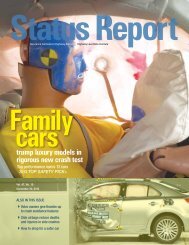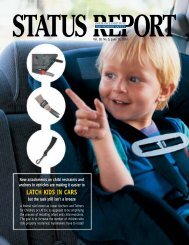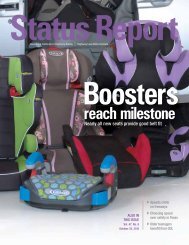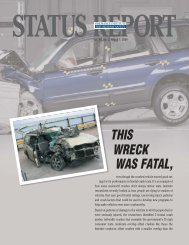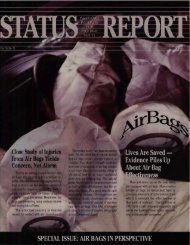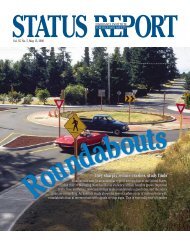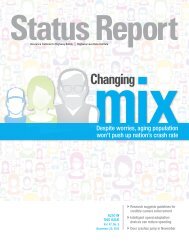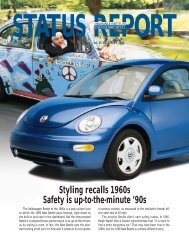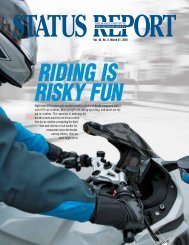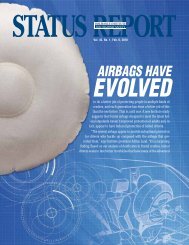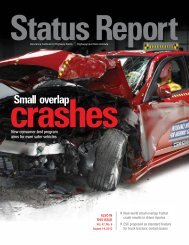Status Report - Insurance Institute for Highway Safety
Status Report - Insurance Institute for Highway Safety
Status Report - Insurance Institute for Highway Safety
You also want an ePaper? Increase the reach of your titles
YUMPU automatically turns print PDFs into web optimized ePapers that Google loves.
Vol. 43, No. 2, March 15, 2008IN YOUR SUV, AND YOUWANT THE ROOF TO HOLDUP SO YOU’RE PROTECTEDfrom injury, including harm from the roof cavingin on you. Every passenger vehicle meets federalrequirements <strong>for</strong> roof strength, measured ina test, and some exceed the requirements by substantialamounts. The question has been whetherstronger roofs actually reduce injury risk in real-
2 <strong>Status</strong> <strong>Report</strong>, Vol. 43, No. 2, March 15, 2008IMPORTANCE OFESC AND SIDE AIRBAGSVehicle roof strength is crucial to occupant protection in rollovercrashes. Other features are effective, too, in both preventingsuch crashes in the first place and protecting people when theirvehicles do roll. Researchers estimate that electronic stabilitycontrol, or ESC, reduces the risk of a fatal single-vehicle rolloverby about 69 percent <strong>for</strong> all passenger vehicles and 72 percent<strong>for</strong> SUVs in particular. Side curtain airbags are expected toreduce the risk of death in the rollovers that still occur.“These technologies are essential,” <strong>Institute</strong> presidentAdrian Lund points out, “but electronic stability control doesn’tcompletely eliminate rollover crashes, and side airbags aren’tthe only protection occupants need if they do roll over. This iswhy we have to pay attention to the roof. If a vehicle’s roofis strong enough to absorb the energy of a rollover withoutcaving in on its occupants, injury risk goes down.”Electronic stability control monitors vehicle response to driversteering and applies the brakes on individual wheels to maintainthe path that’s indicated by the steering wheel position (see<strong>Status</strong> <strong>Report</strong>, June 13, 2006; on the web at iihs.org).This technology is standard or optional on about two-thirdsof all current passenger vehicle models. Side airbags arestandard or optional in about 80 percent.world rollover crashes. Some studies have concluded that the strengthof a vehicle’s roof has little or no effect on the likelihood of injury, buta new <strong>Institute</strong> study indicates that roof strength definitely influencesinjury risk.Researchers tested SUVs in a procedure similar to what the governmentrequires automakers to conduct to assess roof strength and thenrelated the findings to the real-world death and injury experience of thesame SUVs in single-vehicle rollover crashes. The main finding is thatinjury risk went down as roof strength increased.Injury rates vary considerably among vehicles in rollovers, andthere’s still a lot researchers don’t know about these crashes. Forexample, is injury risk primarily from the sudden crushing of the roof?Is it because people crash into the roof when the vehicle is upside down?Or does the main risk come from full or partial ejection of occupantswhen vehicle doors and windows break open during rollover crashes?“We don’t know just what happens to people in these crashes orwhat the injury mechanisms are. What we do know from the new studyis that strengthening a vehicle’s roof reduces injury risk, and reducesit a lot,” says <strong>Institute</strong> president Adrian Lund.Extent of the rollover problem: About 35 percent of all occupantdeaths occur in crashes in which vehicles roll over. This problem isworse in some kinds of vehicles than others. About 25 percent of occupantdeaths in crashes of cars and minivans involve rolling over. Theproportion jumps to 59 percent in SUVs.Of course, the best way to prevent these deaths is to keep vehiclesfrom rolling over in the first place, and electronic stability control ishelping. It’s reducing rollover crashes, especially fatal single-vehicleones, by significant percentages.“But until these crashes are reduced to zero, roof strengthwill remain an important aspect of occupant protection,”Lund points out.What the US government requires: Federal MotorVehicle <strong>Safety</strong> Standard 216 establishes minimum roofstrength <strong>for</strong> passenger vehicles. Compliance testinginvolves the application of a metal plate to one sideof a roof at a constant speed. The roof must withstanda <strong>for</strong>ce of 1.5 times the weight of the vehiclebe<strong>for</strong>e reaching 5 inches of crush. Thus, a vehicleweighing 4,000 pounds has to withstand 6,000pounds of <strong>for</strong>ce while sustaining 5 or fewer inchesof crush.This requirement, in effect since 1973 <strong>for</strong>cars and 1994 <strong>for</strong> other passenger vehicles, isin the process of an upgrade. One of the government’smain proposals, issued in 2005, is toboost the specified <strong>for</strong>ce to 2.5 times vehicleweight (see <strong>Status</strong> <strong>Report</strong>, Jan. 28, 2006; on theweb at iihs.org). Last month the governmentindicated it may consider further altering thestandard by testing both sides of vehicle roofsinstead of applying the <strong>for</strong>ce to one side only.When the changes were proposed in 2005, the<strong>Institute</strong> voiced general support but noted the“surprising lack of evidence” connecting the requirementsof the standard to real-world rollovercrash outcomes.The new <strong>Institute</strong> study provides some missingevidence. Across 11 SUVs at 3 different degrees ofroof crush — 2, 5, and 10 inches — the strongest roofsare associated with injury risks 39 to 57 percent lowerthan the weakest roofs. Peak roof strength at 2 and 10inches of crush is more highly related to injury risk than at5 inches. Based on these findings, the researchers estimatethat if the roofs on every SUV the <strong>Institute</strong> tested were asstrong as the strongest one, about 212 of the 668 deaths thatoccurred in these SUVs in 2006 would have been prevented.“These are big risk reductions, bigger than what the governmentor anybody else has established,” Lund says.The researchers estimate that a 1-unit increase in peak strength-toweightratio — <strong>for</strong> example, from 1.5 times vehicle weight to 2.5, as thegovernment proposed in 2005 — reduces the risk of serious and fatalinjury in a rollover crash by 28 percent. Increasing roof strengthrequirements beyond 2.5 times vehicle weight would reduce injuryrisk even further.
The difference in roof strength was obvious whenthe Nissan Xterra and Ford Explorer, both 2000 models, weresubjected to a crushing <strong>for</strong>ce of up to 10,000 pounds. TheXterra’s roof crushed about 2 inches, and damage is hardlyvisible except <strong>for</strong> a cracked windshield. Meanwhilethe Explorer’s roof crushed 10 inches, caving farinto the occupant compartment even be<strong>for</strong>ereaching 10,000 pounds of <strong>for</strong>ce.
4 <strong>Status</strong> <strong>Report</strong>, Vol. 43, No. 2, March 15, 2008New findings vs. previous studies: Be<strong>for</strong>e the <strong>Institute</strong>’s study,there was no conclusive evidence about the specific contributionof a vehicle’s roof strength to occupant protection. Thegovernment estimated that proposed changes in federalroof strength requirements would save 13 to 44 livesper year.“This was based on assumptions that wereconservative in the extreme,” Lund explains.“For example, the government assumed zerobenefit <strong>for</strong> unbelted occupants. We don’tknow exactly what the benefit of an upgradedroof strength standard would be <strong>for</strong>these occupants, but it would be likely toexceed zero.”Meanwhile two studies sponsoredby automakers, one in 1995 and theother a decade later, found no relationshipat all between roof strength andinjury risk in rollovers. Findings of thefirst study prompted General Motorsto tell The Detroit News in 2002, “Goodscience, long established and well reviewedin the technical literature, hasconclusively demonstrated that there isno relationship between roof strengthand the likelihood of occupant injurygiven a rollover.” Four years later, Fordtold the government that “substantial andcompelling real-world crash data and laboratorytesting have confirmed that simplyincreasing roof strength will not measurablyreduce the risk of injury or death to vehicle occupantsin rollovers.”A main problem with these studies is that theyincluded all kinds of passenger vehicles with their substantialdifferences in driver demographics, rolloverpropensity, and other factors that confound the results. Incontrast, the <strong>Institute</strong>’s new study focuses on one kind of vehicle,midsize 4-door SUVs, and tightly controls <strong>for</strong> other factors thatcould confound the results. While the findings are about a limited numberof SUVs, the researchers conclude that the overall finding ofreduced injury risk as roof strength increases would hold <strong>for</strong> otherkinds of vehicles, although the magnitude of the injury rate reductionmay differ among vehicle groups.Lund adds that the findings “prompt us to expand our research onroof strength with an eye to supplying consumers with comparisons ofhow well vehicles protect people in rollover crashes. A dynamic testwith dummies instrumented to measure injury risk in rollovers wouldbe desirable, but there’s a sticking point. First we have to understandhow the movement of dummies in controlled tests could reflect howreal people move in real-world rollovers. Meanwhile, simpler roofstrength measurements could provide useful consumer in<strong>for</strong>mation.”The drivers of these SUVsdied when their vehicles overturned.It’s a big problem — more thanhalf of all occupant deaths in SUVs occurin rollover crashes. New research indicatesthat strengthening vehicle roofswould reduce this problem. If the roofon every SUV were as strong as the bestone the <strong>Institute</strong> tested, injury risk in rollovercrashes could be reduced 39 to 57 percent.These are very big risk reductions, biggerthan the federal government or anybodyelse has established.Detailsof the study:The <strong>Institute</strong> study is atwo-part analysis involving vehicletesting and examination of the outcomes of real-world rollovercrashes. Eleven midsize 4-door SUVs were subjected to a test similar tothe one run by automakers to comply with federal roof strength requirements(the manufacturers’ own test data aren’t public in<strong>for</strong>mation). The11 SUVs exclude features that might affect injury rates in rollovers suchas side curtain airbags and electronic stability control (see p.2). To
<strong>Status</strong> <strong>Report</strong>, Vol. 43, No. 2, March 15, 2008 5assess the range of roof strength among the SUVs, researchersapplied <strong>for</strong>ce to the roofs until crush reached 10 inches, measuringthe peak <strong>for</strong>ce required <strong>for</strong> 2 inches of crush, 5 inches,and 10 inches. Because crush in a rollover can depend on vehicleweight as well as roof strength, the researchers calculatedstrength-to-weight ratios <strong>for</strong> each degree of crush. They alsomeasured the amount of energy absorbed by each roof at eachdegree of crush and, again taking vehicle weight into account,the height from which the vehicle would have to be droppedto produce equivalent energy absorption.By almost any of these measures, the strongest roof was onthe 2000-04 Nissan Xterra while one of the weakest was on the1999-2004 Jeep Grand Cherokee. Within 5 inches of crush, theJeep withstood a <strong>for</strong>ce as high as 6,560 pounds, whichamounts to 1.64 times the weight of the 4-wheel-drive versionand 1.72 times the weight of the 2-wheel-drive. The correspondingfigure <strong>for</strong> the Xterra was 11,996 pounds, or 2.93 times theweight of the 4-wheel-drive and 3.16 times the 2-wheel-drive.Having established the range of roof strength among theSUVs, the researchers studied almost 23,000 real-worldrollovers of the same 11 SUVs during 1997-2005. This in<strong>for</strong>mationwas collected from 12 states with sufficient data onpolice-reported crashes to comply with study criteria.Logistic regression was used to assess the effect of roofstrength on the likelihood of driver injury in the rollover crashesof the 11 SUVs. The regression controlled <strong>for</strong> state-to-statedifferences in methods of reporting crashes, terrain, urbanization,etc.; vehicle stability; and driver age. Results indicate thevarious injury risks given the various SUV roof strengths.“No matter what measurement of roof strength we usedor whether we measured at 2 or 5 or 10 inches of crush, wefound a consistent relationship between roof strength andinjury risk,” Lund points out.The relationship between roof strength-to-weight ratio andinjury risk was stronger at 2 inches than at 5 inches, the crushspecified <strong>for</strong> testing under the federal standard (the governmentdoesn’t require automakers to assess roof strength at 2or 10 inches). At 5 inches, the predicted injury risk <strong>for</strong> peoplein SUVs with roof strength-to-weight ratios as strong as theXterra’s would be 39 percent lower than <strong>for</strong> people in vehicleswith roof strength like the Grand Cherokee’s. At 2 inches ofcrush, the difference in predicted injury risk is 51 percent.The 11 SUV designs in the study include the 1996-2004Chevrolet Blazer, 2002-05 Chevrolet TrailBlazer, 1998-2003 DodgeDurango, 1996-2001 Ford Explorer, 2002-04 Ford Explorer,1996-98 Jeep Grand Cherokee, 1999-2004 Jeep Grand Cherokee,2002-05 Jeep Liberty, 1997-2004 Mitsubishi MonteroSport, 2000-04 Nissan Xterra, and 1996-2000 Toyota 4Runner.For a copy of “Relationship between roof strength and injuryrisk in rollover crashes” by M.L. Brumbelow et al., write:Publications, <strong>Insurance</strong> <strong>Institute</strong> <strong>for</strong> <strong>Highway</strong> <strong>Safety</strong>, 1005 N.Glebe Rd., Arlington, VA 22201, or email publications@iihs.org.
6 <strong>Status</strong> <strong>Report</strong>, Vol. 43, No. 2, March 15, 2008NECK INJURY RISK ISLOWER IF SEATS ANDHEAD RESTRAINTSARE RATED GOODThe rate of neck injury complaints is 15 percentlower in cars and SUVs with seat/headrestraint combinations rated good comparedwith poor. The results <strong>for</strong> serious injuries aremore dramatic. Thirty-five percent fewerinsurance claims <strong>for</strong> neck injuries lasting 3months or more are filed <strong>for</strong> cars and SUVswith good seat/head restraints than <strong>for</strong> onesrated poor.These are the main findings of a new<strong>Institute</strong> study of thousands of insuranceclaims filed <strong>for</strong> damage to vehicles, all 2005-06 models, that were struck in front-into-rearimpacts. Conducted in cooperation withState Farm and Nationwide, the study is thefirst time seat/head restraint ratings basedon dynamic tests conducted by the <strong>Institute</strong>have been compared with real-world neckinjury results.“In stop and go traffic,you’re morelikely toget in a rear-end collision than any other kindof crash, so you’re more likely to need yourseat and head restraint than any other safetysystem in your vehicle,” says David Zuby, the<strong>Institute</strong>’s senior vice president <strong>for</strong> vehicleresearch. “This is why it’s so important to fitvehicles with seats and head restraints thatearn good ratings <strong>for</strong> saving your neck.”The <strong>Institute</strong> has been measuring and ratinghead restraint geometry since 1995. Thehigher and closer a restraint is, the more likelyit will be to prevent neck injury in a rearcollision. In 2004 the <strong>Institute</strong> added a dynamictest simulating a rear crash to refinethe ratings. Vehicles are rated good, acceptable,marginal, or poor based on both restraintgeometry and test results (see <strong>Status</strong><strong>Report</strong>, Nov. 20, 2004; on the web at iihs.org).The same rating system is used internationallyby a consortium of insurer-sponsoredorganizations, the International <strong>Insurance</strong>Whiplash Prevention Group.An estimated 4 million rear collisions occureach year in the United States. Neck sprain orstrain is the most serious injury in one-third ofinsurance claims <strong>for</strong> injuriesin all kinds of crashes. The annualcost of these claims exceeds$8 billion annually.While findings about realworldneck injury in vehicleseats rated good and poor areclear, those <strong>for</strong> seats ratedacceptable and marginal aren’tas clear. There wasn’t any reductionin initial neck injurycomplaints <strong>for</strong> acceptableand marginal seats,comparedwith poor, though long-termneck injuries were reduced.“The long-term injuriesare the very ones we want toreduce because they’re themost serious,” Zuby pointsout.“While many neck injuriesinvolve moderate discom<strong>for</strong>tthat goes away in a week or so,about one of every four initialcomplaints still was beingtreated three months later.These longer term injuriesinvolve more pain and costmore to treat. They’re beingreduced about onethirdin vehicles with seat/head restraints ratedgood compared withpoor. Serious neck injuriesalso are beingreduced in seats thatare rated acceptableor marginal.Improvements:More and morepassenger vehiclesare beingequipped withseats and headrestraints ratedgood. Whenthe <strong>Institute</strong>started evaluatingandcomparingthe geometryof thehead re-These vehicles didn’t sustaina lot of damage when they werestruck from behind, but the driverswere treated <strong>for</strong> injuries sufferedin the impacts. Neck sprains andstrains are the most serious problemsreported in about 1 of 3 insuranceclaims <strong>for</strong> injuries. This problemcould be reduced by equippingvehicles with seat/head restraintsrated good, based on <strong>Institute</strong> tests.Twenty-nine of all recent model carsand 22 perent of other passengervehicles have systems rated good<strong>for</strong> protection against neck injury.
<strong>Status</strong> <strong>Report</strong>, Vol. 43, No. 2, March 15, 2008 7straints in 1995model cars, only ahandful were rated goodand 80 percent were poor. Thenthe automakers responded, and by 2004 about4 of every 5 head restraints had good or acceptablegeometry (see <strong>Status</strong> <strong>Report</strong>, Nov. 20,2004; on the web at iihs.org). Similarly, thedynamic per<strong>for</strong>mance of seat/head restraintcombinations is improving. Only 12 percent of2004 model cars had combinations ratedgood, but by the 2007 model year the proportionhad increased to 29 percent (see <strong>Status</strong><strong>Report</strong>, Aug. 4, 2007; on the web at iihs.org).These improvements are being driven notonly by ratings of seat/head restraints publishedby the <strong>Institute</strong> and other insurersponsoredgroups but also by a US standardthat will require the restraints to extendhigher and fit closer to the backs of people’sheads by the 2009 model year. In the UnitedStates, automakers also have been spurredby the <strong>Institute</strong>’s TOP SAFETY PICK award.To win this designation, a vehicle has to earngood ratings in all three tests — front, side,and rear.How the injuries occur: When a vehicle isstruck in the rear and driven <strong>for</strong>ward, its seatsaccelerate occupants’ torsos <strong>for</strong>ward. Unsupported,an occupant’s head will lag behindthis <strong>for</strong>ward torso movement, andthe differential motion causesthe neck to bend and stretch.The higher the torso acceleration,the more suddenthe motion, the higher the<strong>for</strong>ces on the neck, andthe more likely a neck injuryis to occur.Factors that influenceneck injury risk include genderand seating position in addition tothe designs of seats and head restraints.Women are more likelythan men to incur neck injuriesin rear crashes, and front-seatoccupants, especially drivers,are more likely to incur suchinjuries than people riding inback seats.The key to reducing whiplashinjury risk is to keep anoccupant’s head and torso movingtogether. To accomplish this, thegeometry of a head restraint has to beadequate — high enough and near the backof the head. Then the seat structure and stiffnessmust be designed to work in concertwith the head restraint to support an occupant’sneck and head, accelerating them withthe torso as the vehicle is pushed <strong>for</strong>ward.About the study: To correlate seat/headrestraint ratings with real-world neck injuryrisk, researchers studied about 3,000 insuranceclaims associated with rear crashes of105 of the 175 passenger vehicles (2005-06models) <strong>for</strong> which the <strong>Institute</strong> has ratingsbased on both restraint geometry and seatper<strong>for</strong>mance in dynamic tests. The claimswere filed with State Farm Mutual <strong>Insurance</strong>and Nationwide <strong>Insurance</strong>, which togetheraccount <strong>for</strong> more than 20 percent of the personalauto insurance premiums paid in theUnited States in 2005. The researchers modeledthe odds of a neck injury occurring in arear-struck vehicle as a function of seat ratings(good, acceptable, marginal, or poor),while controlling <strong>for</strong> other factors that alsoaffect neck injury risk, such as vehicle sizeand type and occupant age and gender.The percentage of rear-struck drivers withneck injury claims was 16.2 in vehicles withseats rated good, based on dynamic testing.Corresponding percentages were 21.1 <strong>for</strong>seats rated acceptable, 17.7 <strong>for</strong> marginalseats, and 19.2 <strong>for</strong> poor ones. Neck injurieslasting 3 months or more were reported by 3.8percent of drivers in good seats, 4.7 percent inacceptable seats, 3.6 percent in marginalseats, and 5.8 percent in seats rated poor.“What these data show is that we’re pushingseat designs in the right direction,” Zubysays, “Results <strong>for</strong> acceptable and marginalseats weren’t as clear as <strong>for</strong> good seats. Initialneck injury claims weren’t significantly lowerthan <strong>for</strong> poor seats. Still we saw reductions inclaims <strong>for</strong> serious neck injuries in acceptableand marginal seats as well as in good ones.”This is the third study the <strong>Institute</strong> hasconducted that indicates the superiority ofseat/head restraint combinations rated good<strong>for</strong> reducing neck injury risk. In 1999 the <strong>Institute</strong>found that head restraints rated goodThe key to reducingwhiplash is to keepoccupants’ heads andtorsos moving <strong>for</strong>wardtogether when theirvehicles are struckfrom behind.<strong>for</strong> geometry alone had lower insuranceclaims <strong>for</strong> neck injuries. In 2003 <strong>Institute</strong> researchersexpanded the data, finding thatmodern features such as head restraints thatautomatically adjust in rear-end collisionsand seats that absorb energy also reduceinsurance claims.For a copy of “Relationship of dynamicseat ratings to real-world neck injury rates”by C.F. Farmer et al., write: Publications, <strong>Insurance</strong><strong>Institute</strong> <strong>for</strong> <strong>Highway</strong> <strong>Safety</strong>, 1005 N.Glebe Rd., Arlington, VA 22201, or email publications@iihs.org.
NON-PROFIT ORG.U.S. POSTAGEPAIDPERMIT NO. 252ARLINGTON, VA1005 N. Glebe Rd., Arlington, VA 22201Phone 703/247-1500 Fax 247-1588Internet: www.iihs.orgVol. 43, No. 2, March 15, 2008Strength of the roofs on SUVs influences the risk ofoccupant injury in rollover crashes, new <strong>Institute</strong>study finds .................................................................1ESC helps keep vehicles from rolling over, andside airbags protect people in the rollovercrashes that still occur .....................................2Demonstration of strong vs. weak roofsshows why roof strength matters ....................3Rollovers in which drivers died demonstrateneed <strong>for</strong> strong roofs on SUVs ............................4Seat/head restraints that earn good ratings, basedon dynamic tests, reduce neck injury risk among driversof rear-struck vehicles .............................................6Contents may be republished with attribution.This publication is printed on recycled paper.The <strong>Insurance</strong> <strong>Institute</strong> <strong>for</strong> <strong>Highway</strong> <strong>Safety</strong> is anonprofit scientific and educational organizationdedicated to reducing deaths, injuries, and propertydamage from crashes on the nation’s highways.The <strong>Institute</strong> is wholly supported by auto insurers:21st Century <strong>Insurance</strong>AAA Mid-Atlantic <strong>Insurance</strong> GroupAffirmative <strong>Insurance</strong>AIG Agency AutoAIG DirectAlfa <strong>Insurance</strong>Alfa Alliance <strong>Insurance</strong> CorporationAllstate <strong>Insurance</strong> GroupAmerican Family Mutual <strong>Insurance</strong>American National Property and CasualtyAmeriprise Auto & HomeAmerisure <strong>Insurance</strong>Amica Mutual <strong>Insurance</strong> CompanyAuto Club GroupAuto Club South <strong>Insurance</strong> CompanyBituminous <strong>Insurance</strong> CompaniesBristol West <strong>Insurance</strong>Brotherhood MutualCali<strong>for</strong>nia State Automobile AssociationCapital <strong>Insurance</strong> GroupChubb Group of <strong>Insurance</strong> CompaniesConcord Group <strong>Insurance</strong> CompaniesCotton States <strong>Insurance</strong>COUNTRY <strong>Insurance</strong> & Financial ServicesCountrywide <strong>Insurance</strong> GroupErie <strong>Insurance</strong> GroupEsuranceFarm Bureau Financial ServicesFarm Bureau Mutual <strong>Insurance</strong> Company of IdahoFarmers <strong>Insurance</strong> Group of CompaniesFarmers Mutual of NebraskaFlorida Farm Bureau <strong>Insurance</strong> CompaniesFrankenmuth <strong>Insurance</strong>The GEICO GroupGainscoGeneral Casualty <strong>Insurance</strong> CompaniesGMAC <strong>Insurance</strong>Grange <strong>Insurance</strong>The Hart<strong>for</strong>dHanover <strong>Insurance</strong> GroupHigh Point <strong>Insurance</strong> GroupHomeowners of AmericaICW GroupIndiana Farm Bureau <strong>Insurance</strong>Kemper, a Unitrin BusinessKentucky Farm Bureau <strong>Insurance</strong>Liberty MutualThe Main Street America GroupMarkel CorporationMercury <strong>Insurance</strong> GroupMetLife Auto & HomeMichigan <strong>Insurance</strong> CompanyMiddleOakMMG <strong>Insurance</strong>Mutual of Enumclaw <strong>Insurance</strong> CompanyNationwide <strong>Insurance</strong>N.C. Farm Bureau Mutual <strong>Insurance</strong> CompanyNodak Mutual <strong>Insurance</strong>Norfolk & Dedham GroupOhio Casualty GroupOklahoma Farm Bureau Mutual <strong>Insurance</strong> CompanyOregon Mutual <strong>Insurance</strong>Palisades <strong>Insurance</strong>Pekin <strong>Insurance</strong>PEMCO <strong>Insurance</strong>The Progressive CorporationResponse <strong>Insurance</strong>Rockingham GroupSafeco <strong>Insurance</strong>Samsung Fire & Marine <strong>Insurance</strong> CompanyS.C. Farm Bureau Mutual <strong>Insurance</strong> CompanySECURA <strong>Insurance</strong>Shelter <strong>Insurance</strong>Sompo Japan <strong>Insurance</strong> Company of AmericaState Auto <strong>Insurance</strong> CompaniesState Farm <strong>Insurance</strong>Tennessee Farmers Mutual <strong>Insurance</strong> CompanyTokio Marine NichidoThe Travelers CompaniesUnitrinUSAAVirginia Farm Bureau Mutual <strong>Insurance</strong>West Bend Mutual <strong>Insurance</strong> CompanyZurich North AmericaFUNDING ASSOCIATIONSAmerican <strong>Insurance</strong> AssociationNational Association of Mutual <strong>Insurance</strong> CompaniesProperty Casualty Insurers Association of America



